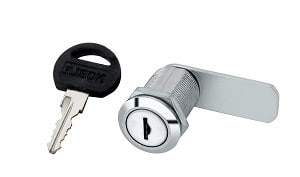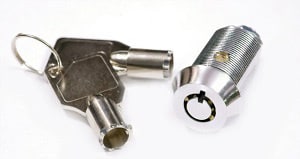To provide a brief description, a cam lock or a locking screw works by fitting the cam in one piece, and the other screw is bolted into its connecting panel. As the cam and the screw fit together, the panels will be tightened down by the cam lock.
This simple mechanism may come across as confusing if you have not seen how a cam lock operates. Let us look further into how does a cam lock work so we can get a clearer understanding of its function.
Table of Contents
What is a Camlock
In hindsight, you may be able to see that a cam lock mechanism is just the same as a regular lock and key system. In essence, that is indeed true.
However, a cam lock uses a rotational motion to tighten its grip on the board compared to a regular knob lock, where its lock is simply located where the knob itself is.
To start with, there are two different kinds of cam locks. The first one is designed like a regular door key which we call the flat type, while the other one is the tubular type.
- Flat Type Cam Locks
Mainly used in cabinets and other furniture, flat-type locks consist of cam screws or cam lock fasteners. The second part is a regular screw bolted to a plate or a panel board.
Firstly, the screws are drilled into their designated spots on the board. The other board panels will have holes wherein the screw heads will be able to fit through. There are also pre-drilled holes on the panels wherein the cam lock nuts will connect to the screw heads.
A furniture cam lock has a hook or a claw where you fasten it to a screw when the panel is attached. Turning the nut clockwise will tighten its grip on the screw head, while turning it counterclockwise will unhinge the nut from the cam screw.
- Tubular Cam Locks
With similar mechanisms, the only difference between a tubular type and a flat type is its design. You can even say that instead of turning the cams clockwise to tighten the grip, it is the screws that are used to secure or unfasten the locks.
A very good example of this will be how a bike lock operates. The tubular lock consists of two connected cylinders and a hollow cylinder that serves as the key or the cam lock.
The cylindrical lock has key pins inside it, preventing it from being unlocked. By inserting the cam into its keyhole, the pins are pushed to a certain depth until the two cylinders are separated.
How to Properly Install a Cam Lock
Attaching this type of lock properly can be a bit tricky so using a cam lock installation tool will come in handy. There are various tools that you will need:
- A cam lock mount
- T26 retaining ring
- 4P3-1 stud pliers
- A 4002T02 mounting tool.
This will guide you in assembling a cam lock conveniently and efficiently.
For instance, as they are mainly placed in cabinet corners and edges, installing them requires a lot of precision, and a regular furniture screw lock may not be suitable to secure the panels of the furniture.
A cam lock nut alternative is often used depending on what type of furniture or fixing is being worked on.
Read more: The detailed guide to installing a cam lock.
Choosing the Right Cam Lock Nut
There are hundreds of nuts that come in various shapes and sizes. There is a certain type of nut to use if you plan something with detachable parts. Getting the right nut for the job will make the function you are aiming for even more effective.
- For example, a pronged tee nut is best used for connecting harder materials. They are often used to join different panels like wood to metal, metal to plastic, and plastic to wood.
- A nut dowel connector, on the other hand, is mostly utilized in furniture repairs such as cupboards and drawers. Meanwhile, a zip bolt connector is best used for staircase handrails as they are capable of holding more tension without loosening up.
Conclusion
Getting started in woodworking or carpentry requires a lot of understanding as this is a very broad skill to master. Learning ‘how does a cam lock work?’ is just one of many areas to explore to fully learn the ropes of this craft.
The cam lock that you choose could either make or break the project you are working on. Researching and knowing every aspect up to the smallest detail shall guarantee you a perfect outcome.

I am the last member to join Revolar and might be just the luckiest to work with dedicated people like Teddy and John. Our team has established a process where my only job is writing the best content to deliver incredible ideas and guides.





